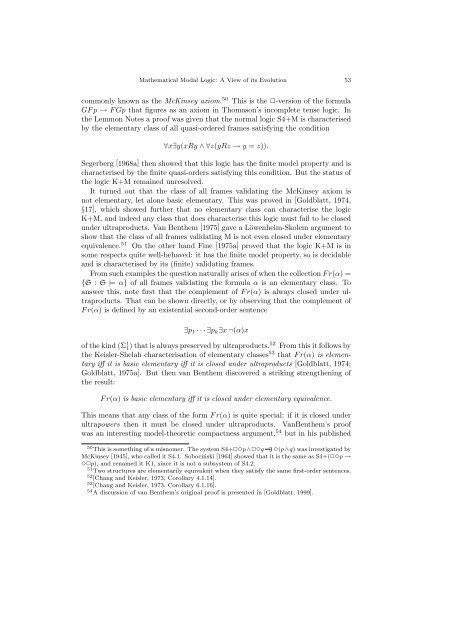MATHEMATICAL MODAL LOGIC: A VIEW OF ITS EVOLUTION
MATHEMATICAL MODAL LOGIC: A VIEW OF ITS EVOLUTION
MATHEMATICAL MODAL LOGIC: A VIEW OF ITS EVOLUTION
Create successful ePaper yourself
Turn your PDF publications into a flip-book with our unique Google optimized e-Paper software.
Mathematical Modal Logic: A View of its Evolution 53commonly known as the McKinsey axiom. 50 This is the ✷-version of the formulaGF p → F Gp that figures as an axiom in Thomason’s incomplete tense logic. Inthe Lemmon Notes a proof was given that the normal logic S4+M is characterisedby the elementary class of all quasi-ordered frames satisfying the condition∀x∃y(xRy ∧ ∀z(yRz → y = z)).Segerberg [1968a] then showed that this logic has the finite model property and ischaracterised by the finite quasi-orders satisfying this condition. But the status ofthe logic K+M remained unresolved.It turned out that the class of all frames validating the McKinsey axiom isnot elementary, let alone basic elementary. This was proved in [Goldblatt, 1974,§17], which showed further that no elementary class can characterise the logicK+M, and indeed any class that does characterise this logic must fail to be closedunder ultraproducts. Van Benthem [1975] gave a Löwenheim-Skolem argument toshow that the class of all frames validating M is not even closed under elementaryequivalence. 51 On the other hand Fine [1975a] proved that the logic K+M is insome respects quite well-behaved: it has the finite model property, so is decidableand is characterised by its (finite) validating frames.From such examples the question naturally arises of when the collection F r(α) ={S : S |= α} of all frames validating the formula α is an elementary class. Toanswer this, note first that the complement of F r(α) is always closed under ultraproducts.That can be shown directly, or by observing that the complement ofF r(α) is defined by an existential second-order sentence∃p 1 · · · ∃p k ∃x ¬(α)xof the kind (Σ 1 1) that is always preserved by ultraproducts. 52 From this it follows bythe Keisler-Shelah characterisation of elementary classes 53 that F r(α) is elementaryiff it is basic elementary iff it is closed under ultraproducts [Goldblatt, 1974;Goldblatt, 1975a]. But then van Benthem discovered a striking strengthening ofthe result:F r(α) is basic elementary iff it is closed under elementary equivalence.This means that any class of the form F r(α) is quite special: if it is closed underultrapowers then it must be closed under ultraproducts. VanBenthem’s proofwas an interesting model-theoretic compactness argument, 54 but in his published50 This is something of a misnomer. The system S4+✷✸p∧✷✸q 3 ✸(p∧q) was investigated byMcKinsey [1945], who called it S4.1. Sobociński [1964] showed that it is the same as S4+(✷✸p →✸✷p), and renamed it K1, since it is not a subsystem of S4.2.51 Two structures are elementarily equivalent when they satisfy the same first-order sentences.52 [Chang and Keisler, 1973, Corollary 4.1.14].53 [Chang and Keisler, 1973, Corollary 6.1.16].54 A discussion of van Benthem’s original proof is presented in [Goldblatt, 1999].
















